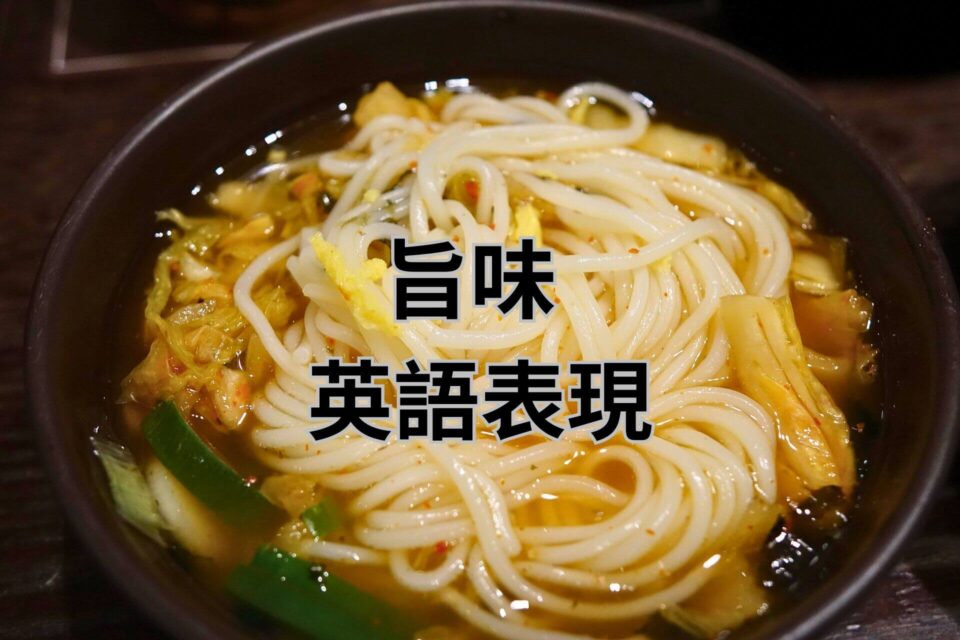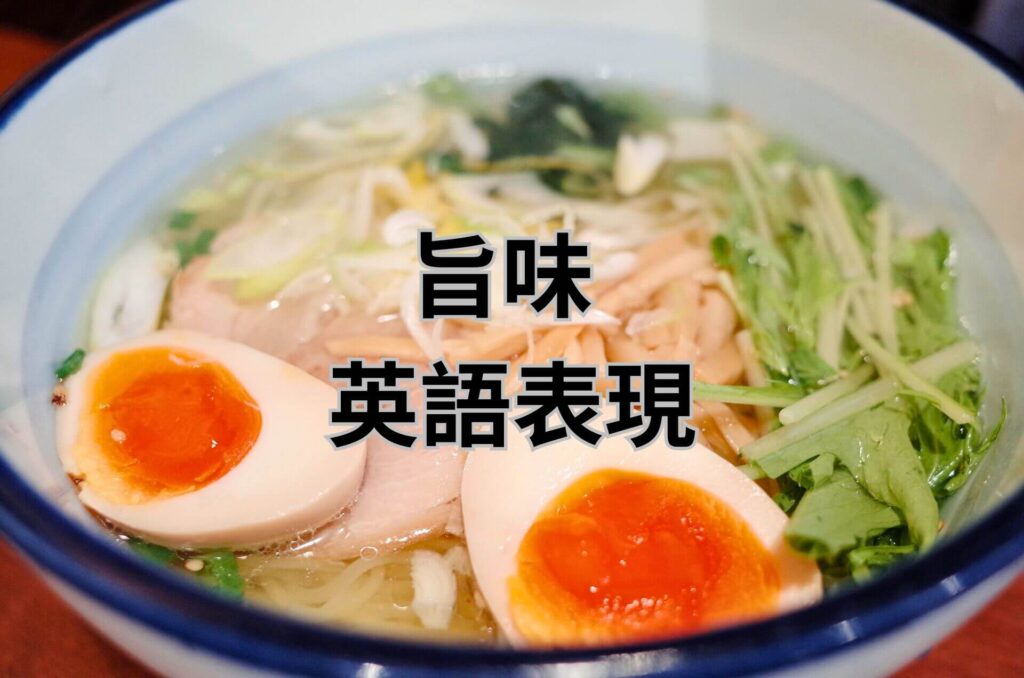旨味 英語表現10選! 例文 会話例 誤用例 記憶のフックで習得しましょう!
和食を食べていると、旨味について考えさせられることが多いものです。同じ料理を食べていても、旨味があるかどうか?で料理に対する印象が大きく変わるものです。
今回は「旨味 英語表現」をまとめてみました。
旨味 英語では?
旨味 英語表現
| 英語表現 | ニュアンス / 直訳 | 使用される場面 | 注意点 |
|---|---|---|---|
| umami | 日本語「旨味」そのまま | 食文化紹介、国際的な料理用語。専門的な場面やグルメ記事で多用。 | 英語話者でも知らない人はいるが、料理関係では定着しつつある。 |
| savory | 塩気・旨味のある、香ばしい | 甘いものと対比して「しょっぱい/旨味のある料理」を指すとき | 「甘くない」という意味でも使うので「旨味」と直結しない場合あり。 |
| rich flavor | 濃厚な風味、深みのある味 | スープ・煮込み・チーズなど長時間調理で味が凝縮している場合 | 「脂っこい」にも聞こえることがあるので文脈注意。 |
| deep flavor | 奥行きのある風味 | 出汁・発酵食品・熟成酒などに使いやすい | 「味が複雑で重なり合っている」というニュアンス。 |
| meaty flavor | 肉のような旨味 | 肉系以外でもキノコ・大豆など「肉に似た旨味」を指す時 | 野菜や代替肉の旨味を表すのによく使う。 |
| brothy | 出汁の効いた、スープっぽい旨味 | ラーメン・スープ・煮込み料理 | 少しカジュアル。主に液体料理に適する。 |
| mouth-filling taste / full-bodied taste | 口いっぱいに広がる旨味、ボディのある味 | ワイン・スープ・チーズなど「重層的で広がる味」 | お酒やスープに多用されるフォーマル寄り表現。 |
| complex flavor | 複雑な旨味 | 発酵食品、ワイン、チーズ、スパイスの組み合わせ | 「旨味」以外に酸味や苦味も含む複雑さを示す。 |
| succulent | ジューシーで旨味がある | 肉や果物など、水分と旨味が豊かなもの | 食感のジューシーさも含むため、固形食材向き。 |
| hearty flavor | 力強い、濃厚で温かみのある旨味 | 煮込み料理、スープ、パンなど「食べ応え」のある料理 | ボリューム感・温かみを含むニュアンスが強い。 |
旨味 英語例文
例文と和訳
1. umami
The miso soup has a strong umami that makes it very satisfying.
味噌汁には強い旨味があって、とても満足感がある。
Parmesan cheese is rich in umami.
パルメザンチーズは旨味が豊富だ。
Many chefs describe mushrooms as a source of natural umami.
多くのシェフは、キノコを天然の旨味の源と表現する。
2. savory
This broth has a wonderfully savory taste.
このスープは驚くほど旨味のある味だ。
I prefer savory dishes to sweet ones.
甘い料理よりも旨味のある料理の方が好きだ。
Soy sauce gives food a savory depth.
醤油は料理に旨味の深みを与える。
3. rich flavor
The stew has a rich flavor from slow cooking.
煮込み料理はじっくり煮込むことで濃厚な旨味が出ている。
Aged cheese develops a rich flavor over time.
熟成チーズは時間とともに濃厚な旨味を生む。
This ramen broth has a rich flavor from pork bones.
このラーメンスープは豚骨の濃厚な旨味がある。
4. deep flavor
The dashi gives the dish a deep flavor.
出汁が料理に深い旨味を与えている。
Slow-roasted tomatoes bring a deep flavor to the sauce.
ゆっくりローストしたトマトがソースに深い旨味を加える。
The wine has a deep flavor that lingers.
このワインには長く残る深い旨味がある。
5. meaty flavor
Mushrooms often have a meaty flavor despite being vegetables.
キノコは野菜なのに肉のような旨味を持っていることが多い。
This sauce has a meaty flavor from beef stock.
このソースにはビーフストック由来の肉のような旨味がある。
Soy protein sometimes gives dishes a meaty flavor without using meat.
大豆タンパクは肉を使わなくても料理に肉のような旨味を与えることがある。
6. brothy
The ramen was delicious with a brothy richness.
そのラーメンは、だしの効いた旨味があって美味しかった。
This soup has a light but brothy taste.
このスープはあっさりしているが、だしの旨味がある。
I love the brothy quality of chicken noodle soup.
チキンスープのだしの旨味が大好きだ。
7. mouth-filling taste / full-bodied taste
The soy sauce adds a full-bodied taste to the dish.
醤油が料理に口いっぱいに広がる旨味を加えている。
The stew has a mouth-filling taste thanks to the beef stock.
ビーフストックのおかげで、その煮込みは口いっぱいに広がる旨味がある。
The miso gives the soup a full-bodied taste.
味噌がスープにしっかりした旨味を与える。
8. complex flavor
This wine has a complex flavor with layers of umami.
このワインには複雑で重なり合った旨味がある。
Fermented foods often develop a complex flavor.
発酵食品は複雑な旨味を生み出すことが多い。
The sauce combines spices for a complex flavor.
そのソースはスパイスを組み合わせて複雑な旨味を作り出している。
9. succulent
The steak was juicy and succulent.
そのステーキはジューシーで旨味たっぷりだった。
Fresh seafood is always succulent.
新鮮な魚介はいつも旨味が豊かだ。
These tomatoes are sweet and succulent.
このトマトは甘くて旨味がある。
10. hearty flavor
The stew has a hearty flavor that warms you up.
その煮込みは心まで温まるような力強い旨味がある。
A hearty flavor comes from the long-simmered vegetables.
長時間煮込んだ野菜から力強い旨味が出ている。
This bread has a hearty flavor from whole grains.
このパンには全粒粉由来の力強い旨味がある。
旨味 英語会話例

1. umami
A: Have you ever tried Japanese dashi?
B: Yes, when I visited Tokyo last year, I had it in miso soup. It had this unique umami taste that I couldn’t really describe in English.
A: That’s the magic of umami—it doesn’t fall into sweet, salty, sour, or bitter.
B: Right. It feels like the fifth taste. I even read that scientists recognize it as its own category.
A: Exactly. That’s why people now just use the word umami around the world.
和訳
A: 日本の出汁を飲んだことある?
B: うん、去年東京に行った時に味噌汁で飲んだよ。英語では説明できない独特の旨味があった。
A: それが「旨味」の魔法だよ。甘味・塩味・酸味・苦味のどれにも当てはまらないんだ。
B: そうだね。まるで「第五の味覚」だよね。科学的にも独立した味として認められてるって読んだよ。
A: その通り。だから世界中で「umami」という言葉がそのまま使われてるんだ。
2. savory
A: I made this pie for dinner. Want to try it?
B: Sure! Oh, it’s delicious. It’s not sweet at all—it’s wonderfully savory.
A: Yeah, I used mushrooms, onions, and herbs instead of sugar or fruit.
B: I love it. It’s the kind of flavor that makes you want to eat more. Not like dessert, but still so satisfying.
A: Exactly. That’s why savory pies are popular in Europe, especially in Britain.
B: I can see why. It’s filling, flavorful, and feels like a proper meal.
和訳
A: このパイを夕食用に作ったんだ。食べてみる?
B: もちろん!わぁ、美味しい。全然甘くないね。旨味たっぷりだ。
A: うん、砂糖やフルーツの代わりにキノコや玉ねぎ、ハーブを使ったんだよ。
B: 最高だね。デザートとは違うけど、すごく満足感があってもっと食べたくなる味だよ。
A: でしょ?だからヨーロッパ、特にイギリスではこういう「セイボリーパイ」が人気なんだ。
B: 納得だよ。お腹も満たされるし、風味も良くて本当の食事って感じだね。
3. rich flavor
A: Wow, this stew smells incredible.
B: Thanks! I cooked it slowly for six hours. That’s why it has such a rich flavor.
A: I can really taste how the beef and vegetables melted together.
B: Exactly. The longer you simmer, the richer it becomes. The flavors deepen and combine naturally.
A: It reminds me of something my grandmother used to make. You don’t need many spices when the flavor is this rich.
B: True. Sometimes patience is the best seasoning.
和訳
A: わぁ、この煮込み、すごくいい匂いだね。
B: ありがとう!6時間かけてじっくり煮込んだんだ。だから濃厚な旨味が出てるんだよ。
A: 牛肉と野菜が溶け合ってるのがよくわかる。
B: そうそう。時間をかけるほど旨味が増して、自然に味が深くなるんだ。
A: おばあちゃんがよく作ってくれた料理を思い出すよ。これだけ旨味が濃厚なら、たくさんスパイスを入れる必要もないね。
B: その通り。時には「時間」が一番の調味料なんだよ。
4. deep flavor
A: This miso soup tastes amazing. It’s different from the one I usually make.
B: The secret is in the dashi. I used kombu and bonito flakes, which give it a deep flavor.
A: Oh, I can feel it. It’s not just salty—it has layers that stay in your mouth.
B: Exactly. That’s why Japanese cooking emphasizes broth. It creates comfort and depth.
A: I think I could drink this every morning and never get tired of it.
和訳
A: この味噌汁すごく美味しいね。いつも自分で作るのと違う味だよ。
B: 秘密は出汁だよ。昆布と鰹節を使って深い旨味を出したんだ。
A: あぁ、わかる。ただ塩辛いんじゃなくて、口に何層も残る感じだね。
B: そうなんだ。だから日本料理は出汁を大切にするんだよ。安心感と深みを生むからね。
A: 毎朝飲んでも飽きなさそうだよ。
5. meaty flavor
A: These mushrooms are so good. Are you sure there’s no meat in this dish?
B: None at all! But mushrooms have a natural meaty flavor that makes them taste like steak.
A: I can see that. It’s hearty but still light. Perfect for a vegetarian meal.
B: Exactly. That’s why many chefs use mushrooms or soy protein to replace meat.
A: Honestly, I didn’t miss the meat at all. This could fool a carnivore!
和訳
A: このキノコ料理めっちゃ美味しいね。本当にお肉入ってないの?
B: 全然入ってないよ!でもキノコには自然な肉のような旨味があるから、ステーキみたいに感じるんだ。
A: なるほどね。食べ応えがあるのに軽くて、ベジタリアン料理にぴったりだ。
B: そうそう。だから多くのシェフは肉の代わりにキノコや大豆タンパクを使うんだよ。
A: 正直、お肉がなくても全然物足りなくなかった。肉好きの人でも騙されそうだね!
6. brothy
A: This ramen broth is amazing. I can’t stop drinking it.
B: Right? It’s so brothy, almost like a hug in a bowl.
A: It feels light, but at the same time, it has depth from the dashi.
B: Exactly. The chef probably used chicken bones, kombu, and dried fish to get that layered flavor.
A: No wonder it tastes so balanced. It’s not oily, just full of essence.
B: That’s the beauty of a good broth—it nourishes without being heavy.
和訳
A: このラーメンのスープ最高だね。飲むのをやめられないよ。
B: でしょ?まるで丼の中のハグみたいに、旨味が出てるんだ。
A: 軽いのに、出汁からくる深みもあるね。
B: そうそう。たぶん鶏ガラと昆布、魚の干物を使って層のある味を出してるんだと思う。
A: なるほど、だからこんなにバランスが取れてるんだ。脂っこくなくて、旨味のエッセンスが詰まってる感じだね。
B: いい出汁の魅力ってそこなんだよ。重たくないのに体を満たしてくれるんだ。
7. full-bodied taste
A: This wine pairs beautifully with the pasta.
B: I agree. Both have a full-bodied taste that fills your mouth completely.
A: It’s interesting—neither one overpowers the other. They kind of dance together.
B: That’s the art of pairing. A full-bodied wine needs food with equal depth, or it feels unbalanced.
A: Makes sense. The sauce is rich, and the wine stands up to it perfectly.
B: Exactly. When flavors are this full, every sip and bite feels complete.
和訳
A: このワイン、パスタとすごく合うね。
B: だよね。どっちも口いっぱいに広がる旨味があるからだよ。
A: 面白いね。どちらかが強すぎるんじゃなくて、一緒に踊ってるみたい。
B: それがペアリングの技なんだよ。フルボディのワインには同じくらい深みのある料理が必要なんだ。そうじゃないとバランスが崩れるんだよ。
A: なるほど。ソースは濃厚だけど、ワインが完璧に受け止めてるんだね。
B: その通り。ここまで味が満ちていると、一口ごとに完成した世界を感じられるよ。
8. complex flavor
A: This curry is fascinating. Every bite tastes slightly different.
B: Yeah, that’s because it has such a complex flavor. The spices mix and reveal themselves gradually.
A: First I get something sweet, then a bit of heat, and finally a deep earthy taste.
B: Exactly! That’s the beauty of complexity—it keeps surprising you.
A: It’s like listening to a piece of music with many instruments. You notice new things each time.
B: Perfect comparison. A complex flavor is like a symphony in your mouth.
和訳
A: このカレー、面白いね。食べるたびに少しずつ違う味がするよ。
B: そうだよ。複雑な旨味があるからなんだ。スパイスが混ざり合って、順番に顔を出すんだよ。
A: 最初に甘さを感じて、それから辛味、最後に土のような深い味わいが来るね。
B: そうそう!複雑さの魅力って、次々に驚かせてくれることなんだ。
A: まるで楽器がたくさん入った音楽を聴くみたいだね。聴くたびに新しい音に気づく。
B: まさにその通り。複雑な味は口の中の交響曲だよ。
9. succulent
A: This steak is out of this world.
B: I know! It’s so succulent—juicy, tender, and full of flavor.
A: I don’t even need any sauce. The meat itself is perfect.
B: That’s the sign of quality. When the meat is cooked right, the natural juices carry all the umami.
A: Every bite feels like it melts, but still has that satisfying chew.
B: Exactly. Succulent food is unforgettable because it engages both taste and texture.
和訳
A: このステーキ、信じられないくらい美味しいね。
B: でしょ?すごくジューシーで旨味たっぷりなんだ。柔らかくて風味も最高。
A: ソースなんて全然いらないよ。お肉そのものが完璧だ。
B: それが良い肉の証拠だよ。ちゃんと調理されると、自然な肉汁が旨味を全部運んでくれるんだ。
A: 一口ごとにとろける感じがするけど、ちゃんと噛み応えもある。
B: そうそう。ジューシーで旨味のある食べ物って、味覚と食感の両方に残るから忘れられないんだよ。
10. hearty flavor
A: I love this vegetable soup. It’s perfect for a cold evening.
B: Yeah, it has such a hearty flavor—rich, warm, and comforting.
A: It makes me feel like I’m eating at my grandmother’s house.
B: That’s the power of hearty food. It doesn’t just fill your stomach; it warms your heart.
A: I could eat this every winter night and never get bored.
B: Same here. A hearty flavor feels like home, no matter where you are.
和訳
A: この野菜スープ大好き。寒い夜にぴったりだね。
B: だよね。力強くて、温かみがあって、安心できる旨味があるよね。
A: まるでおばあちゃんの家で食べてるみたいな気持ちになるよ。
B: それが「ハーティーフード」の力なんだ。お腹を満たすだけじゃなくて、心まで温めてくれるんだ。
A: 毎晩冬に食べても飽きないと思う。
B: 僕もだよ。こういう力強い旨味って、どこにいても「家」を感じさせてくれるんだよ。
旨味 誤用例・注意点
1. umami
❌ 誤用例: This cake has a lot of umami.
(このケーキは旨味がある → 甘いケーキには不自然)
⚠️ 注意点: 「umami」は出汁・肉・発酵食品などに限られる。スイーツには基本使わない。
2. savory
❌ 誤用例: The chocolate is very savory.
(このチョコはしょっぱい/旨味がある → ほとんどのチョコは甘いので混乱する)
⚠️ 注意点: savory は「甘くない系の料理」に限定。甘いものと併用しない。
3. rich flavor
❌ 誤用例: This water has a rich flavor.
(水に濃厚な味がある → 水は基本的に「クリア」「フレッシュ」で表現)
⚠️ 注意点: 「rich」は スープ・ソース・肉料理に適切。軽い食べ物・飲み物には不自然。
4. deep flavor
❌ 誤用例: This chewing gum has a deep flavor.
(ガムに奥深い味わいがある → 長時間の煮込みや発酵ではないので不自然)
⚠️ 注意点: 「deep」は時間や工程をかけた料理に使う。加工食品や軽食には合わない。
5. meaty flavor
❌ 誤用例: This orange has a meaty flavor.
(オレンジに肉っぽい味がある → 果物に使うと意味不明)
⚠️ 注意点: 「meaty」はキノコ・豆類・代替肉に使えるが、フルーツやスイーツには使わない。
6. brothy
❌ 誤用例: This steak tastes brothy.
(ステーキがスープっぽい → 固形の肉料理には不自然)
⚠️ 注意点: 「brothy」は**液体料理(スープ・ラーメン)**に限定。固形食材には基本不使用。
7. full-bodied taste / mouth-filling taste
❌ 誤用例: This cucumber has a full-bodied taste.
(キュウリにフルボディの味 → 軽い野菜には合わない)
⚠️ 注意点: 「full-bodied」はワイン・スープ・コーヒー・チーズなど、濃厚で重みのある食品に使う。軽い食材は不自然。
8. complex flavor
❌ 誤用例: This plain rice has a complex flavor.
(白ご飯に複雑な味がある → 素材そのままはシンプル)
⚠️ 注意点: 「complex」は発酵・熟成・スパイス料理に使う。シンプルな食材や味には不向き。
9. succulent
❌ 誤用例: This soup is very succulent.
(スープがジューシー → 液体にジューシーは不自然)
⚠️ 注意点: 「succulent」は肉や果物の「噛んだときに汁があふれる」食材に使う。液体やドライなものには合わない。
10. hearty flavor
❌ 誤用例: This salad has a hearty flavor.
(サラダに力強い味わい → 軽食には不自然)
⚠️ 注意点: 「hearty」はスープ・煮込み・パンなどボリューム感のある料理に使う。軽い料理には不自然。
旨味 記憶のフック
1. umami
TIPS: 日本語由来。「うまい味 → umami」。
フック: 「寿司や味噌汁と一緒に世界に輸出された日本語」と覚える。
2. savory
TIPS: 「save(守る)」に似ている → 「甘さから逃げて守る=しょっぱい・旨味系」。
背景: 英語では「savory = 甘くない食べ物全般」を意味し、イギリスでは前菜やしょっぱい軽食を指すことも。
フック: 「ケーキよりもチップス」→ Savory snacks。
3. rich flavor
TIPS: 「お金持ちはリッチ → 味もリッチ=濃厚」。
背景: ワインやソース、煮込み料理の評価で頻出。単純に「味が濃い」というより「層がある・コクがある」。
4. deep flavor
TIPS: 「深い海・深い洞窟=深い味わい」。
背景: 出汁文化を説明する時に便利。西洋でもワインやコーヒーの複雑な味に使われる。
5. meaty flavor
TIPS: 「meat=肉 → 肉っぽい味」。
背景: キノコ・大豆製品(tofu, soy burger)の味を説明する時に定番。ヴィーガン文化で特によく使われる。
フック: 「キノコ=森の肉 → meaty flavor」。
6. brothy
TIPS: 「broth=スープの出汁 → brothy=出汁っぽい」。
背景: 西洋料理でもチキンスープやブイヨン文化が根付いているのでよく使う。
7. full-bodied taste / mouth-filling taste
TIPS: 「ボディがある=体にズシンと来る味」。
背景: ワインの表現から派生。「light-bodied」「full-bodied」といった形容はソムリエ必須用語。
フック: 「ワイン評論家がよく言う『フルボディ』=濃厚な旨味」。
8. complex flavor
TIPS: 「complex=複雑な集合体 → 味が重なり合う」。
背景: ワイン・チーズ・発酵食品のレビューでよく使われる。単純な甘さ/塩気ではなく、層のある味を褒める言葉。
フック: 「納豆やキムチの味は complex flavor」。
9. succulent
TIPS: 「サボテンの多肉植物=succulent → 水分いっぱい → ジューシーで旨味がある」。
背景: 主に肉や果物を形容。汁気が旨味を運ぶイメージ。
フック: 「succulent steak=噛んだら肉汁あふれるステーキ」。
10. hearty flavor
TIPS: 「heart=心 → 心が温まる味」。
背景: 欧米では「hearty soup」「hearty meal」で「ボリュームがあって満足感がある料理」を意味。
フック: 「寒い日に食べるシチュー=hearty」。
語彙力UP情報
・味 英語



コメント